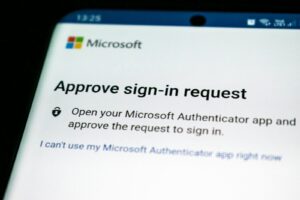The Rising Importance of Secure Authentication in IoT Networks
Why Push Notification-Based MFA is Essential for IoT Devices
Push notification-based MFA is a two-step verification process that enhances the security of IoT devices by requiring users to confirm their identity through a notification sent to their mobile devices. This method offers an additional layer of security beyond traditional password-based authentication, which is often vulnerable to cyberattacks. For business executives and mid-level managers, understanding the importance of push notification-based MFA is crucial in fortifying their organization’s IoT infrastructure against potential threats.
Convenience and Security Combined: The Benefits of Push Notification MFA
One of the primary benefits of push notification-based MFA for IoT devices is the balance it strikes between convenience and security. Traditional authentication methods, such as passwords, can be cumbersome and prone to security breaches. In contrast, push notification MFA streamlines the authentication process by allowing users to quickly verify their identity with a single tap on their mobile device. This ease of use encourages widespread adoption among employees, reducing the risk of security lapses due to human error or negligence.
Moreover, push notification-based MFA significantly enhances security by leveraging the inherent security features of modern smartphones, such as biometric authentication (fingerprint or facial recognition) and encryption. These additional layers make it exceedingly difficult for unauthorized users to gain access to IoT networks, even if they manage to obtain a user’s login credentials. For entrepreneurs and project managers in the region, implementing push notification-based MFA is a strategic move to safeguard their IoT systems while maintaining a user-friendly experience for their workforce.
Challenges and Considerations in Implementing Push Notification MFA
While push notification-based MFA offers numerous benefits, it is not without its challenges. One of the primary concerns is ensuring the reliability of the mobile network or internet connection required to receive the notifications. In regions with fluctuating connectivity, such as remote areas or during high network traffic periods, delays in receiving push notifications can disrupt the authentication process and potentially impact business operations.
Another consideration is the management of mobile devices within an organization. Ensuring that all employees’ devices are equipped with the necessary security features, such as up-to-date operating systems and secure apps, is essential for the effective implementation of push notification-based MFA. Additionally, businesses must have contingency plans in place for scenarios where employees lose access to their mobile devices, such as lost or stolen phones. Implementing a secure backup authentication method can mitigate the risk of such incidents.
Guidelines for Implementing Push Notification-Based MFA in IoT Systems
Establishing a Secure and Scalable Infrastructure
The successful implementation of push notification-based MFA for IoT devices requires a secure and scalable infrastructure. Businesses should begin by selecting a reliable MFA service provider that offers robust security features, such as encryption and compliance with industry standards. The chosen provider should also support integration with the organization’s existing IoT infrastructure, ensuring a seamless deployment process.
It is essential to establish a secure communication channel between IoT devices and the MFA service. This can be achieved through the use of encryption protocols, such as TLS (Transport Layer Security), to protect data in transit. Furthermore, businesses should ensure that their network architecture is designed to handle the increased traffic resulting from push notifications without compromising performance or security. For business leaders in Saudi Arabia and UAE, investing in a scalable infrastructure is crucial to accommodate future growth and the expanding adoption of IoT technologies.
Ensuring User Adoption and Compliance
User adoption is a critical factor in the success of any security measure, including push notification-based MFA. To encourage widespread adoption, businesses should prioritize user education and training. Employees must understand the importance of MFA in protecting the organization’s IoT systems and the potential consequences of non-compliance. Providing clear instructions and support for setting up and using push notification-based MFA can help alleviate any resistance or confusion.
Additionally, businesses should establish clear policies regarding the use of mobile devices for authentication. These policies should include guidelines for securing personal devices, such as enabling biometric authentication, regularly updating software, and avoiding the installation of unauthorized apps. Regular audits and compliance checks can help ensure that employees adhere to these policies, further strengthening the organization’s security posture.
Continuous Monitoring and Improvement
The implementation of push notification-based MFA is not a one-time task but an ongoing process that requires continuous monitoring and improvement. Businesses should regularly review and update their MFA policies and practices to address emerging threats and vulnerabilities. This includes staying informed about the latest developments in MFA technologies and adapting to new security challenges as they arise.
Monitoring the performance of the MFA system is also crucial. Businesses should track metrics such as authentication success rates, response times, and user satisfaction to identify areas for improvement. Regular security assessments and penetration testing can help identify potential weaknesses in the MFA system and provide actionable insights for enhancing its effectiveness. For business executives and project managers in Riyadh and Dubai, maintaining a proactive approach to MFA management is key to ensuring the long-term security and resilience of their IoT systems.
Conclusion
In conclusion, push notification-based MFA is a powerful tool for enhancing the security of IoT devices while providing a convenient authentication method for users. By implementing this approach, businesses can significantly reduce the risk of unauthorized access and protect their IoT networks from cyber threats. However, successful implementation requires careful planning, user education, and continuous monitoring to ensure its effectiveness.
For business leaders and entrepreneurs in Saudi Arabia, UAE, Riyadh, and Dubai, embracing push notification-based MFA is a strategic decision that aligns with the region’s commitment to technological innovation and security. By prioritizing the security of their IoT systems, businesses can safeguard their operations, protect sensitive data, and maintain a competitive edge in the global market.
—
#PushNotificationMFA #IoTSecurity #MultiFactorAuthentication #Cybersecurity #BusinessSuccess #LeadershipSkills #ProjectManagement #ArtificialIntelligence #SaudiArabia #UAE #Riyadh #Dubai













